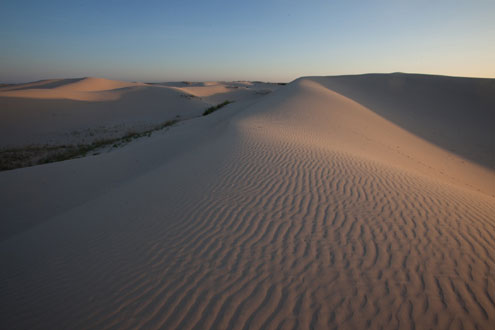The dunes
The Texas Permian Basin is notorious for its sameness. Broad stretches of creosote bush is broken only by the numerous pump jacks sipping crude oil from the soil that was once the bottom of an ancient sea. For the unappreciative, this is drive-through country - only a place you have to go through to get to where you are going. However, if you slow down and take a look, you’ll see that the area is alive with all kinds of wildlife, an interesting plant community, and shape-shifting sand dunes that flank one of the world’s largest oak forests.
While driving down Texas Highway 115 near Kermit, I first saw the geologic anomaly a few years ago. South of the highway, the dunes alternate between the open sand and vegetation covered humps. To the north, the dunes are a broad expanse of sand that stretches as far as I can see - the bright white sand standing in contrast to the blue West Texas sky.

This area near Kermit is just a small part of a broader dune field that stretches north to south for 200 miles across West Texas. While most of the field is stabilized by vegetation, a few areas have no vegetation and the dunes ripple and move with the wind and create a dynamic, ever-changing landscape.
My travels took me eight miles east of Monahans, Texas to visit the Monahans Sand Dunes State Park. Here you’ll find nearly 4,000 acres of dune habitat that’s home to a variety of wildlife like porcupines, mule deer, skunks, jackrabbits, coyotes, and bobcats.
You’ll also see the diminutive shinnery oak tress. At a less than impressive four feet tall when mature, the trees blanket the area and make up one of the largest contiguous oak forest in the world.
I arrived at the state park at sunrise. After a night of the wind shifting the white silica sand, there were no signs of anyone having walked through the dunes the day before. Instead, I saw the tracks of coyotes, small rodents, and bugs bisecting the crests.
Because of the prevailing southeasterly wind, the dune’s ridgelines generally point south to north. The windward side gently slopes up from the sandy basins while the leeward side typically drops off at a much steeper angle.
After an hour or so photographing the dunes in the soft morning light, my wife and kids soon join me. Stopping by the park’s headquarters they rented plastic sand disks with which they would ride the slopes.
We spend the morning climbing up the slopes and sliding back down - blissfully ignoring the rising thermometer until the heat and the sun made the sand too hot to walk barefoot. While we sand surf, a few other families arrive to enjoy the park by exploring the dunes just as we are. However, the park never gets crowded.
It is fascinating that places like this exist. Juxtaposed against the monotony of the Permian Basin, the sand dunes rise in contrast. When we leave, my kids are a couple of pounds heavier because of the sand that found its way into their pockets and sticking to their sweaty skin.
Check out www.russellgraves.com for top-notch photography, outdoor articles, videos, and more! On Facebook: russellgraves.com